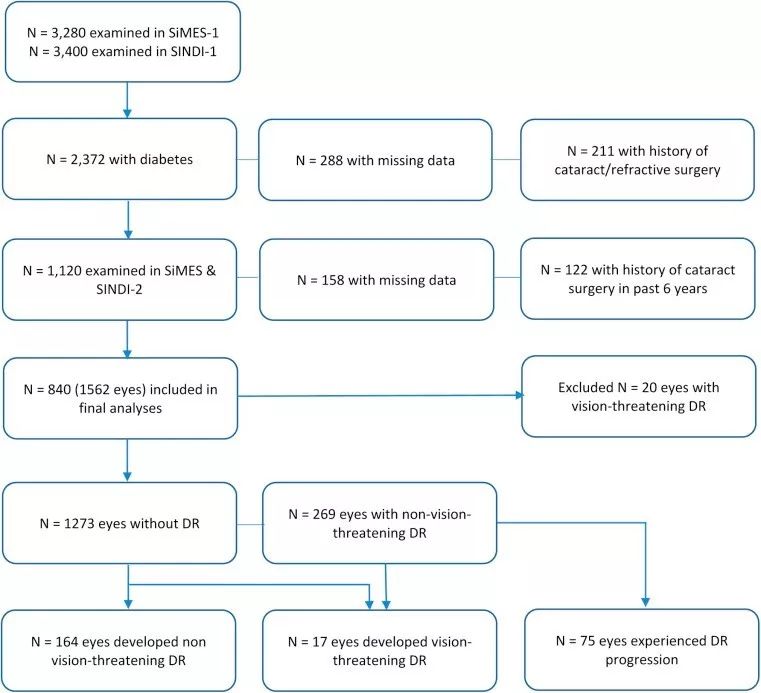Is myopia related to the occurrence and development of diabetic retinopathy?
- Normal Liver Cells Found to Promote Cancer Metastasis to the Liver
- Nearly 80% Complete Remission: Breakthrough in ADC Anti-Tumor Treatment
- Vaccination Against Common Diseases May Prevent Dementia!
- New Alzheimer’s Disease (AD) Diagnosis and Staging Criteria
- Breakthrough in Alzheimer’s Disease: New Nasal Spray Halts Cognitive Decline by Targeting Toxic Protein
- Can the Tap Water at the Paris Olympics be Drunk Directly?
Is myopia related to the occurrence and development of diabetic retinopathy?
Is myopia related to the occurrence and development of diabetic retinopathy? The study proved that a longer axial length can reduce the risk of DR, regardless of refraction or other biological parameters of the eye.
Combined with the results of some previous studies, it is shown that the elongated eyeball plays a vital role in the protective relationship of refractive error to DR.
American Journal of Ophthalmology

Diabetic retinopathy (DR) is a serious microvascular complication of diabetes. If left untreated, it may cause massive and irreversible loss of peripheral and central vision. A large number of studies have focused on the risk and protective factors of DR. Among them, refractive error (RE) is one of the protective factors of DR. It is theoretically believed that the increased eye axis can reduce the metabolism and blood supply of the eyeball. .
However, most studies to date have failed to clarify the above causal relationship, and fewer studies have attempted to clarify the axis of the eye (such as axial length [AL] and anterior chamber depth [anterior chamber depth, ACD]) and refractive The relationship of elements (such as corneal curvature [CC]) in RE-DR. However, a deep understanding of these underlying mechanisms is very important for exploring new therapies for DR.
Recently, a study published in the American Journal of Ophthalmology, a journal of Elsevier, discussed the above issues in depth.
The Singapore Malay Eye Study (SiMES-1 and -2) and the Singapore Indian Eye Study (SINDI-1 and 2) are based on a cohort study of 40-80-year-old Malays and Indians living in Singapore. The initial inspections were completed between 2004-2006 and 2007-2009, and follow-up inspections were completed successively between 2011-2013 and 2013-2015. A total of 840 diabetic subjects were included in the study, and the initial and follow-up study parameters were recorded, including graded fundus images, refractive power, and ocular biological parameters (AL, ACD, and CC); all subjects had no cataracts or refraction History of surgery.
In order to facilitate statistical analysis, the researchers defined three outcomes:
- New-onset DR-there was no DR at the beginning, but it became ill during follow-up;
- New-onset vision-threatening DR (VTDR)-VTDR (>51 grade and/or occurrence of clinically significant macular edema) during follow-up;
- Disease progression (≥ grade 1*).
* The commonly used criterion is progression of ≥2 grades, but in this study, the number of patients with progression grade ≥2 was very small (n=19).

The average age of the 840 subjects was 57.0 years, of which 405 (48.2%) were women. Among the subjects’ 1562 eyes, 289 (18.5%) had DR, and 20 (6.9%) were classified as VTDR.
Of the 1273 eyes without DR at the beginning, a total of 164 eyes (12.9%) developed DR at follow-up; out of 1542 eyes without VTDR at the beginning, 17 eyes (1.1%) developed VTDR at follow-up; at least at the beginning Among the 269 eyes with the smallest grade of DR without VTDR, 75 eyes (27.9%) progressed to grade ≥1 at the time of follow-up.
Compared with subjects without DR, subjects with DR are younger, have higher BMI and HbA1c, are more likely to use insulin and myopia, and have a shorter initial axial length. In the model adjusted for age and gender, longer axial length and lower SE (Spherical equivalent) are associated with lower risk of DR. After multivariate adjustment, the significant correlation between eye axis length and DR still exists, but the correlation between SE and DR disappears.
The study proved that a longer axial length can reduce the risk of DR, regardless of refraction or other biological parameters of the eye. Combined with the results of some previous studies, it is shown that the elongated eyeball plays a vital role in the protective relationship of refractive error to DR.
The long-term high blood sugar in diabetic patients can cause chronic damage and dysfunction of various tissues, especially eyes, blood vessels, nerves, etc. The eye disease caused by diabetes is clinically called diabetic retinopathy. About 27% of diabetic patients will be complicated by diabetic retinopathy. As the course of the disease increases, the probability of complications gradually increases.
According to the current treatment methods and levels, the early treatment of diabetic retinopathy has a better effect. Due to the irreversibility of lesion damage, prevention is the most important part, and the cost of early prevention is much lower than the cost of late surgical treatment, and the effect is better. It is clinically recommended for patients with diabetes to have mydriatic examination of the fundus regularly, especially for patients with a long course of disease.
(source:internet, reference only)
Disclaimer of medicaltrend.org



